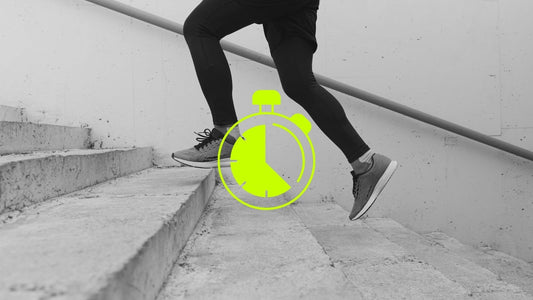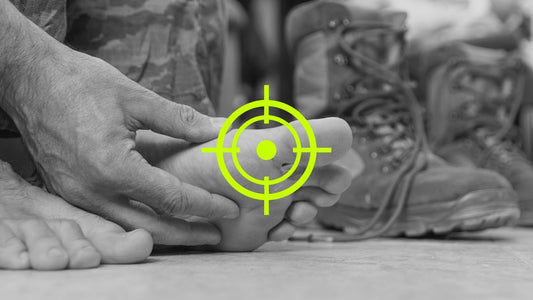Why Lifting Weights Makes You Faster (And Saves Your Knees)
Let’s settle this once and for all: running alone won’t make you a better runner. Whether you’re training for your first 5K or chasing ultras, strength training can make you faster, improve endurance, and help keep injuries at bay.
We’re here to break down why building strength is your secret weapon—whether you’re chasing a 5K PB or just want to run without your knees sounding like a bowl of Rice Krispies. Plus, we’ll share how to keep your feet happy while you’re at it.
Why Strength Training Makes a Difference for Runners
Boosts Running Economy & Performance
Strength training improves the efficiency and power of your running muscles. Why? Because stronger muscles = more force with every stride. Most runners stick to low-weight, high-rep workouts that focus on building functional strength—not turning into the Incredible Hulk.
A 12-week study on recreational runners between the ages of 30-40 showed that adding running-specific strength work—like squats and jumps—significantly improved explosive power and running economy (how efficiently you use oxygen) more than logging extra miles did. Similarly, highly-trained runners saw 5–7% gains in running economy after 14 weeks of heavy resistance training (sportsmedicine-open.springeropen.com).
Fewer Injuries, More Running
If you’ve had to swap your trainers for the couch because of shin splints, runner’s knee, or IT band syndrome, you’re not alone. Running is hard on the body, and repetitive motions can lead to overuse injuries. Strength training stabilizes your joints and builds resilient muscles, meaning your body can withstand all the miles you’re putting in.
Stronger muscles, ligaments, and tendons = fewer surprises. One 18‑week study found compliant runners who did strength work and foam-rolling were 85% less likely to get injured (onlinelibrary.wiley.com). A large meta-analysis also notes that strength training can cut overuse injury rates in half (runcoach.org).
Endurance for the Long Haul
Running a marathon isn’t just about sheer cardio fitness—it’s about muscular endurance. Strength training helps delay the point where your legs feel like jelly at mile 18. Squats, lunges, and deadlifts train your muscles to keep firing for longer, giving you the staying power to crush your goals.
Run Tall and Proud
Ever noticed your form falling apart during a tough run? Weak core muscles might be the culprit. Strength training improves posture and helps you maintain proper running mechanics, even when you’re exhausted. And good form isn’t just about looking pro as you stride through the finish line—it prevents unnecessary wear and tear on your body.
Stronger bones
Running alone slows bone loss, but https://theros.org.uk/information-and-support/bone-health/exercise-for-bones/.
The Best Type of Strength Exercises for Runners (No Gym Required)
Heavy resistance training improves running economy in distance runners.
Plyometrics (think box jumps) team up with strength work to improve power and speed.
Bodyweight strength helps new runners build muscle control, stronger core muscles, and avoid early injuries.
Try these exercises first:
Squats
Targets: Glutes, quads, hamstrings, and core
Why they’re great for runners: Squats improve overall leg strength and stability, helping you power through every step. Start with bodyweight squats, then add dumbbells or a barbell as you progress.
Deadlifts
Targets: Hamstrings, glutes, and lower back
Runner perks: Deadlifts are the holy grail for building power and protecting against lower-body injuries. Plus, they translate directly to explosive strength for uphill runs.
Lunges
Targets: Glutes, quads, hamstrings, and calves
Why you’ll love them (eventually): They work each leg individually, which is key for runners who rely on perfect balance and coordination mid-stride.
Planks
Targets: Core muscles
Why they’re a must-do: A strong core equals better posture and efficiency. Hold a forearm plank to start, then try variations like side planks for an extra challenge.
Calf Raises
Targets: Calves (of course)
Runner advantage: Strong calves absorb impact and reduce the risk of Achilles injuries—so you’re not hobbling around post-run.
Glute Bridges
Targets: Glutes and hamstrings
Dynamic gains: Strengthen your posterior chain to prevent common runner issues like IT band syndrome. Bonus—you can even do these on a yoga mat at home.
How to Add Strength Training to Your Running Routine
Are you worried strength workouts will eat into your running time? A couple of sessions per week are plenty to see results. Here’s how to balance both without sacrificing your mileage.
Start With Twice a Week
Plan two strength training sessions on low-mileage or rest days. Think of it as “active recovery” that makes you stronger instead of leaving you sofa-bound. Trust us, your body will thank you later.
Keep It Short and Sweet
You don’t need marathon-length sessions in the gym. Focus on quality over quantity—aim for 30–45 minutes of targeted strength work.
Choose Compound Movements
Compound exercises (the ones that work multiple muscle groups at once) are your best friends. Think squats, lunges, deadlifts, and planks. These moves mirror the motions of running, which means they directly translate to improved performance.
Recovery: Because Sore Muscles Happen
Strength training can leave you stronger, faster, and less injury-prone. But what about the not-so-glamorous side effects of pushing your body? We’re talking blisters, chafing, and sore muscles that could derail your training plans. Try these 100% natural ingredient solutions and give your skin and body the care it needs to support you reaching your goals.
Post workout, massage our natural muscle rub (with arnica and menthol) into achy legs to soothe micro-tears.
To prevent blisters, slather Chafe Guard anti chafe balm on thighs, underarms, sports bra likes, and anywhere prone to blisters before long runs.
Stronger Runs Start Today
Adding strength training to your running routine might feel a bit out of your comfort zone, but trust us—it’s a game-changer. From running faster and longer to reducing injuries and making hills slightly less soul-destroying, lifting weights can transform your performance.
With just two short sessions a week and a handful of effective exercises, you can build the power, endurance, and resilience needed to crush your goals. And when soreness or chafing tries to get in your way? Chafe Guard and our muscle rub have you covered.
Now, grab those dumbbells, power through your squats, and get ready to run like never before. Your stronger, faster, unstoppable self is waiting!





